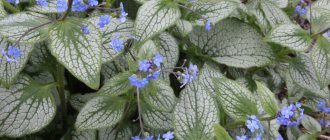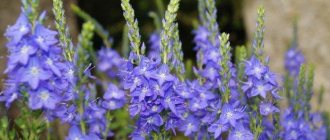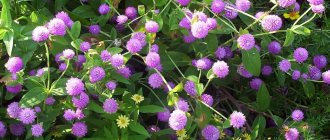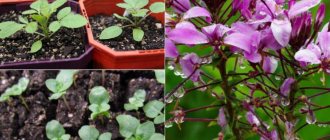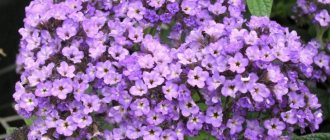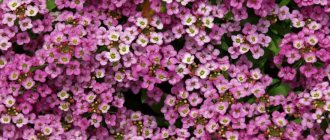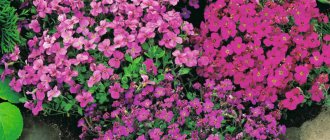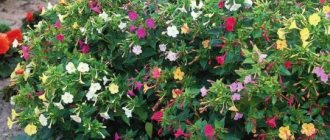Peering at the flowers of the dwarf iris, you freeze at the beauty that appears from under the snow. We are accustomed to snowdrops and crocuses, but dwarf or reticulated iris, also known as iridodictium, is no less good, and maybe even more interesting.
Biology
Family - Iridaceae (killer whales);
Genus - Iridodictium. “Iris” is a rainbow and “diction” is a mesh.
The genus includes 11 species growing in the foothills and mountains of Asia and the Caucasus. Most species are very frost-resistant. Not all dwarf irises are reticulate. Eg:
- I. Vinogradova (winogradowii) feels great in cultivation, can bloom and bear fruit in one place for more than 20 years;
- I. Danfordiae (danfordiae) blooms for 3 years, then falls out (requires digging and drying annually);
- I. reticulatum is represented by a rich set of varieties and hybrids.
Consider the bulbous iris, reticulate
Its bulb consists of:
- outer mesh-fibrous scales;
- internal tunicate scales;
- several small rudimentary scales in the center of the bulb.
The bulb is spherical or ovoid in shape. Up to 2 cm in diameter. The roots are filamentous, numerous, and do not branch. During the dormant period they die off.
The leaves are ground, tetrahedral or multifaceted, narrowly grooved. At the moment of flowering below the peduncle. Then they often stretch up to 50 cm. The foliage remains decorative until June (some varieties do not allow the foliage to turn yellow at all).
The peduncle is single-flowered. Underdeveloped during flowering period. When the seed capsule ripens, it reaches 3–8 cm.
Flowers are 5-7 cm in diameter. Some varieties have a rather strong aroma.
However, the height of the plant (up to 10 cm) does not allow you to catch their smell (well, only if you get on your knees). If you use the bulbs for forcing for the holiday, then it is quite possible to feel the delicate aroma of flowers.
The flowers are brightly colored. The seed pod is triangular. The seeds are small.
Description
Gardeners call iridodictium flowers: reticulated or iridescent iris, reticulated bulb. The thing is that its name consists of two words: rainbow and mesh. There are bright spots or stripes on the leaves of the iridodictium flower. And on the top layer of the bulb you can see a mesh of scales.
Under natural conditions, the flower grows in the mountains of Turkey, Iran, and Central Asia. There are more than 10 species. All of them are very beautiful, with magnificent color and delicate aroma. These flowers are similar to both irises and crocuses, but they are so original that it is impossible to confuse them with other flowers.
So, Iridodictium is a bulbous plant. Each bulb produces a peduncle about 30 centimeters high. The flowers are large and reach a diameter of 9 centimeters. They consist of three inner and three outer sheets. A total of six leaves. They can be yellow, pink, purple, burgundy, lilac, with or without a pattern.
Iridodictium in landscape design
For a long time, the iridodictium flower has been planted in flower beds and lawns. Many varieties exude a wonderful aroma, giving the iris even more charm. A special effect can be achieved if you plant crocuses, hyacinths or primrose nearby. Bright, beautiful flowers peek out from under the snow early, delighting those around them with the arrival of spring. Sometimes the plant is grown in pots.
Today, the iridodictium flower is an invariable attribute of alpine slides. An excellent view will be revealed to the observer if the iris is planted on the south side of the stones, and not in individual bushes, but in entire groups, reminiscent of asymmetrically shaped clearings.
Landing
Some gardeners claim that there are no difficulties in planting and caring for this plant. Planted and dug up - that’s all the work, and the flower itself will bloom in due time. In practice, things are not so simple. In order to get a flowering clearing of iridodictiums, you need to know the peculiarities of growing this plant.
- Flowers do not tolerate waterlogging and stagnation of water. This must be taken into account when choosing a landing site. A layer of gravel in the planting hole will protect the plant from stagnant moisture and provide good drainage.
- The soil should be light and fertile; when planting, add sand to the soil.
- Iridodictium does not like an acidic environment, and therefore it is necessary to choose neutral soil for planting.
- The place should be sunny and well lit, it is better if it is elevated.
- Before planting, we carefully inspect the bulbs and select healthy ones without signs of disease.
- The time for planting iridodictium is autumn. The distance between the bulbs can be from 5 centimeters to 10 centimeters. It all depends on the size of the bulb.
- The planting depth can be more than 10 centimeters. This is the peculiarity of landing. The fact is that iridodictium produces many small daughter bulbs (babies). Three plant bulbs can produce up to a hundred children. Deep planting protects, to some extent, from excessive division.
Agricultural technology
Having chosen the bulbous iris, planting is carried out under the following conditions:
- The location of the bed is sunny (the sunniest);
- Soils - loose, fertile, sandy or sandy loam;
- Soil acidity - neutral or slightly alkaline;
- Groundwater is not allowed;
- Planting depth - 5-7 cm;
- Wintering - without shelter (withstands up to minus 21 ᵒC)
Landing (September)
Shoots (March)
Flowering (March, April)
A little about the species
Reticulated iris Georg (Iris reticulata Georg)
The most beautiful bulbous iris in my garden. I love it for its bright, large flowers the color of ripe plums and its delicate, barely perceptible sweetish aroma. The purple petals of the plant are decorated with bright yellow stripes and blue sparkles.
The Georg iris is only 15 centimeters tall and can grow in shade or partial shade. Flowers bloom in early April.
Reticulated iris Katharine (Iris Katharine)
Catarina netted irises look like beautiful, delicate, exquisite butterflies. These are delicate blue flowers with bright blue veins. Each petal of the iridodictium flower is decorated with yellow spots, blue stripes and specks.
All this creates a subtle, graceful pattern of amazing beauty. The flowers are large, the distance for planting is 10-20 centimeters. The planting location is sunny or partial shade.
Gordon's reticulated iris (Iris reticulata Gordon)
I would like to call these flowers of incredible beauty “flower moths.” Fragrant, blue irises will captivate you with their extraordinary tenderness.
Features of care
During the formation of buds, the flower must be systematically watered. If there was a lot of snow in winter, there is no need to moisten the soil. In summer, it is recommended to feed the plant with mineral fertilizers. You can also use rotted compost or humus.
The plant can grow for 4-5 years without transplantation. However, after flowering it requires fairly high temperatures and dry conditions. Therefore, it is recommended to hide the crop from summer rains. To do this, the landing site is covered.
If the region is characterized by a large amount of precipitation, the tubers are dug up after the growing season. This is done when a third of the leaves turn yellow.
Community of little green men
Iridodictyum, Iridodictium. The earliest of the bulbous irises. Miniature plants are 10–15 cm tall, the peduncle of which is hidden in the ground, and large (5–8 cm in diameter) fragrant flowers appear above the ground, rising due to the perianth tube. Iridodictiums bloom in early spring, as soon as the snow melts.
Etymology of the name
The Greek word iridodictium translates to "net bulb".
Types and varieties of iridodictiums
In nature, representatives of the genus are found in Central, Asia Minor and Western Asia and Transcaucasia.
The genus Iridodictium was isolated from the genus Iris only in 1961 by our compatriot Dr. Georgy Ivanovich Rodionenko. Of the 9 (11) natural species of iridodictium, 4 are most often used, as well as varieties created on their basis that are less demanding on growing conditions.
The flower consists of six perianth lobes. The outer lobes are located horizontally and have a bright yellow or orange stripe in the middle, turning into a white spot. The inner lobes are slightly corrugated, narrow, raised upward and in the upper part are divided into two tongues and often have a more delicate color than the outer ones. Each flower lives for about a week.
Of the iridodictiums, the most famous in culture is Iridodictyum reticularum, better known as reticulate iris.
Iridodictyum reticularum
Homeland - Caucasus.
The flowers rise above the ground by 10-16 cm, the flowers are about 6 cm in diameter. In the natural form, the flowers are purple with a bright yellow stripe on the outer perianth lobes, but light blue forms are also found. The bent part of the lower lobe is called the marigold. Subulate tetrahedral leaves continue to grow after flowering and reach a length of 65 cm. The bulb is ovoid, up to 2.5 cm in diameter.
Based on this species, many varieties have been created, including hybrid ones, mainly by the Dutch company Van Tubergen.
Popular varieties of Iridodictium reticulum:
'Cantab' - single-color, dark blue flower, the outer perianth lobes are decorated with an orange longitudinal ridge running to the center along the midrib;
'Clairette' - two-color flower: the outer perianth lobes are dark, purple, with a white spot in the center and a faint yellow longitudinal ridge along the midrib, the nail is lilac, on the sides with diagonal purple veins;
'Harmony' - monochromatic blue flower, outer perianth lobes with yellow longitudinal ridge;
'JS Dijt' - monochromatic, purple-violet flower, outer perianth lobes with orange longitudinal ridge;
'Jeannine' and 'Cantab' - flowers with even lighter bright yellow stripes along the outer lobes;
'Natascha' - monochromatic flower, bluish-white, outer perianth lobes with a small yellow spot;
'Joyce' - monochromatic blue flower, outer perianth lobes with orange longitudinal ridge;
'Spring Time' - two-color flower, the outer perianth lobes are velvety, purple-violet, with a faint yellow spot on the marigold, a white longitudinal ridge;
'Violet Beauty' - monochromatic flower, dark purple, velvety, orange spot, narrow;
'Wentworth' - single-colored purple flower; outer perianth lobes with orange longitudinal ridge. The variety is distinguished by relatively large perianth lobes.
Rare cultivated species of Iridodictium
Another Caucasian species is Iridodictyum winogradowii with large light yellow flowers, very rare in nature.
Iridodictyum winogradowii
A plant with light yellow flowers. The outer lobes of the perianth bear an orange ridge, decorated along the nail with a dark pattern.
The well-known variety 'Katharine Hodgkin' has a large flower and a mixture of pale blue and yellow flowers. From a distance the flowers appear greenish.
Iridodictium histrioides, or Iridodictyum histrioides
The species grows in the mountains of central Turkey.
The flowers are large and blue. The species is distinguished by the complete absence of leaves during flowering.
Varieties of Iridodictium histrioid:
Several varieties are grown in cultivation: 'Major', 'Lady Beatrix Stanley', 'GP Baker', which differ in the details of flower color.
'George' is a variety of hybrid origin that has the characteristics of a natural appearance - a large red-violet flower and weak leaf development at the beginning of flowering. The diameter of the flower is at least 8 cm. The outer perianth lobes are somewhat darker than the inner ones, with a longitudinal dark purple ridge and a yellow spot on a whitish background, dotted with purple strokes.
Iridodictyum danfordiae
Homeland - Türkiye.
The species is distinguished by the bright yellow color of its flowers. The flowers lack internal perianth segments.
Caucasian and Turkish iridodictiums, and especially varieties obtained from them, are easily grown in gardens in central Russia without digging. All they need is a sunny place, at least in spring, and good drainage.
Iridodictium care
Choose a place for iridodictiums that is sunny and protected from the wind. The soil requires well-drained soil, with the addition of sand, neutral or slightly alkaline reaction.
Spring plant care involves watering, loosening the soil and removing weeds. In the spring, mineral fertilizers, including potash, are applied in small doses.
In rainy years, iridodictium bulbs may rot.
Iridodictiums are highly cold-resistant and do not need shelter for the winter.
Reproduction of Iridodictium
Without transplantation, iridodictiums can grow for 6-8 years. They are propagated by daughter bulbs. Children grow up by planting them at a shallow depth. Iridodictiums are planted in the second half of September or slightly earlier. Planting is done in groups in which the plants are located at a distance of 5-7 cm from each other.
Natural species can be propagated by seeds. Seeds are sown immediately after collection. They bloom in 3-4 years.
Diseases and pests
If the soil is moistened excessively, there is a risk of fungal diseases. At the same time, the bulbs change their color, acquiring an inky hue. In such a situation, it is recommended to remove the plants from the site and burn them. Then the soil is treated with fungicides.
Iridodictium is a beautiful plant that is very popular among gardeners. It has excellent decorative properties and is easy to maintain. To achieve lush flowering, it is very important to establish a watering regime and apply fertilizers on time.
Reproduction
The plant can be propagated vegetatively or by seed.
It is recommended to plant the bulbs at a depth of 6-12 cm - it all depends on their size. In this case, it is worth observing an interval of 10 cm. It is recommended to dig up tubers in June, when the leaves turn yellow. Don't wait for them to dry completely. Then the bulbs should be dried at +23 degrees for several days. After which they are cleaned and stored until mid-August at the same temperature. Then it needs to be reduced to +17 degrees.
Large flowering bulbs often break up into many small fragments. It will not be possible to wait for such plants to bloom. In such a situation, you will have to purchase new planting material.
To collect seeds from Iridodictium, it is necessary to perform artificial pollination. They should be planted immediately after harvest. Thanks to this, next year it will be possible to get the first shoots. They are planted in the garden bed, and after 2 years they are moved to a permanent place. It will be possible to wait for flowering only after 3-4 years from the moment of planting.
Iris bulbs

